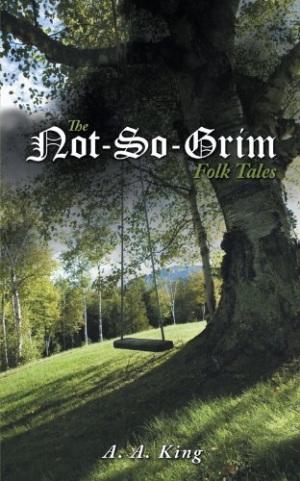The Not-So-Grim Folk Tales
In the Enchanted Forest, everything is magical, the animals never eat each other, and a talking frog might really be a prince. Be forewarned, however, that magical does not mean perfect. Sometimes a leprechaun has a little trouble with his spell book and things go a bit astray. Welcome to the Western Folklore Faerie Circle, and the irresistible imagination of A.A. King.
The reclusive King, whose online presence consists entirely of a web site with an eerie image of treetops against the night sky—see www.KingsForest.net—has clearly thought about folk tales for a good long while. The author’s frequent nods to the folklore genre display an intimacy with classic folklorists like the Brothers Grimm as well as with more modern storytellers like J.K. Rowling and Terry Pratchett. The references are incidental and readers who do not recognize a quotation won’t mind; those who instantly understand characters like the raven, who keeps saying “Nevermore” will, however, be delighted by the Poe reference.
Each short story in The Not-So-Grim Folk Tales immerses readers in a world of princes and princesses, gnomes and elves, fairies and shape shifters. One might expect these to be outlandish stories filled with high romance and dark drama. King, however, concentrates less on the glamorous side of the fantasy and simply presents the Enchanted Forest as a real place, and the folklore persons real people. They have their own life problems to solve, and the answers do not necessarily come any easier for those carrying a wand.
The solutions King’s characters come up with are both heartwarming and hilarious. Snarky truth-telling mirrors and sarcastic elves deliver the one-liners while the main characters quite seriously attend to business. Some stories go more directly for the laugh, but a couple shine with a subtle mix of romance and tragedy as well.
The twenty-four stories collected here focus on an imagined location in Ireland, circa 1850. King gives them an old-fashioned feeling with horses for transportation; the only cell phone appears in a time-travel tale. Each story stands alone as a complete fable, but the characters reappear in many stories throughout the book. Audience members could happily choose just one piece to enjoy, but King’s accessible style encourages readers to continue to turn the page.
Intended for children and young adults, King uses generous spacing and a large font to tell his tales. The collection is definitely not just for children, though, and certainly has an audience in adults who may have wondered what it would be like to live inside some of their favorite stories.
Reviewed by
Sheila M. Trask
Disclosure: This article is not an endorsement, but a review. The publisher of this book provided free copies of the book and paid a small fee to have their book reviewed by a professional reviewer. Foreword Reviews and Clarion Reviews make no guarantee that the publisher will receive a positive review. Foreword Magazine, Inc. is disclosing this in accordance with the Federal Trade Commission’s 16 CFR, Part 255.

